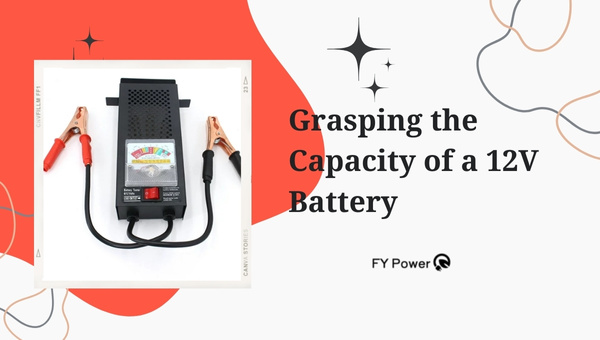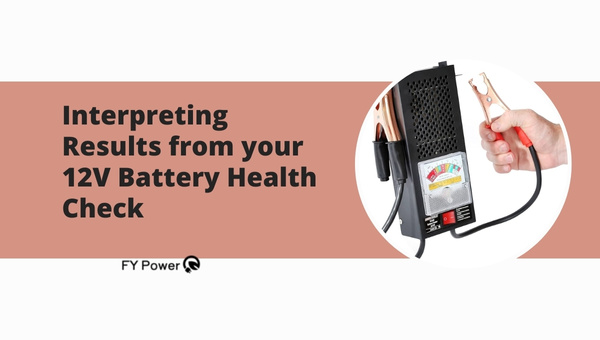Welcome to the exciting world of battery care! If you’ve ever wondered, “How can I check my 12V battery’s capacity?” you’re in the right place. There’s more than meets the eye when it comes to a successful 12V battery health check.
Being aware of its current state not only increases its life span but also safeguards you from inconvenient breakdowns and replacements. Let’s dive in, shall we?
Checking a 12V battery‘s capacity doesn’t require any magic tricks or complex skills. All you need is a voltmeter or multimeter for measuring voltage and possibly something called a load tester if you want more thorough insights into your battery’s health.
Then it’s just about knowledge – knowing all about the concept of battery capacity, interpreting your test results, and understanding how often you should do these checks to keep everything running smoothly.
What You Will Discover Here:
- An easy understanding of what exactly “battery capacity” means
- The critical importance of regular checks on battery health
- A step-by-step guide to performing a comprehensive analysis
- How to interpret results from your inspection
- Useful maintenance tips following your successful 12V Battery Health Check
Grasping the Capacity of a 12V Battery
The capacity of a 12V battery is measured in amp-hours (Ah), indicating the amount of current it can deliver over a period of time.

For example, a 12V battery with a capacity of 100Ah can provide 100 amps for 1 hour or 10 amps for Understanding the capacity of a 12V battery involves knowing its amp-hour (Ah) rating, which reflects the energy charge that the battery can hold and supply over time.
When I talk about a battery’s capacity, I mean how much power it can hold and supply over time. It’s like how much water a bucket can hold, except it’s electricity in the battery instead of water. This capacity matters a lot because it tells you how long your battery will run your stuff before it needs a charge.
Capacity is measured in amp hours (Ah). The higher the number here, the more power you’ve got stored in there. If you understand this number, you make better choices – like not getting stuck with a dead battery when you need it most.
Here’s why knowing about capacity is important for your 12V battery:
- Longevity: Just like muscles get tired if you work out too much, batteries wear out faster if they always run low on juice.
- Performance: Try running on an empty stomach and see how far you get – batteries are the same. Low capacity means less energy to work with.
- Savings: Knowing what’s up with your capacity means no surprises and no wasted cash on new batteries all the time.
- Optimized usage: It’s about being smart with what you’ve got; use your power wisely based on what the numbers tell you.
Imagine driving without watching fuel levels or trying to fill an air mattress without checking if there’s enough air left; that’s why knowing your 12V battery’s capacity is key to keeping everything running smoothly.
Also Read: DIY Portable Solar Panel Stand: An Easy Guide
Step By Step Guide For Performing a 12V Battery Health Check
To perform a 12V car battery health check, first, ensure safety by wearing protective gear and checking the manufacturer’s guidelines. Begin with a visual inspection of the battery for corrosion or damage.
Use a voltmeter/multimeter to measure voltage, which should be around 12.6 volts. A 12V battery health check is essential for vehicle maintenance. Start by turning off the vehicle and wearing safety gear.
Gather Necessary Tools For Checking
When I want to check the health of a 12V battery, I need to have the right tools for this job. Here’s what I gather before starting:
- Multimeter: This is a gadget that measures voltage, current, and resistance. For battery checks, it helps me see if the power is at the right level.
- Hydrometer (for lead-acid batteries): This tool lets me check the specific gravity of the liquid inside each battery cell.
- Load tester: To put pressure on the battery and see how well it holds up, a load tester mimics real-world use.
- Gloves and goggles: Safety first! Batteries can be dangerous so I don’t forget these while working.
- Battery post cleaner or wire brush: Keeping connections clean is key for accurate tests.
The Inspection Phase
I start by looking at the battery carefully:
- First off, I check it’s clean on top to stop any dirt from faking test results.
- Next, tight connections are a must; so if clamps look wonky or wires hang loose, that gets fixed.
- Searching for cracks or leaks is also on my list as they spell bad news for batteries.
- Corrosion near posts or terminals? I’ve got to clear that up with my bristle brush.
With these steps done right, I know nothing will mess with my measurements.
Voltage Measurement
Time for some actual testing – here’s what I do with my voltmeter:
- Turn on the voltmeter and set it up to measure volts DC since that’s what batteries use.
- Connect its red probe to the positive terminal and the black one goes on negative – gotta make sure they stay put!
- Now read what pops up – usually between 12.4 volts and 12.7 volts means we’re good because that’s where fully charged sits.
Staying within those numbers means my battery starts off strong in this health check.
Load Testing
Even if voltage looks fine without a hitch, we’re not out of woods yet; load testing truly shows me if this battery can hustle when needed:
- Hook up a load tester following its instructions; these gadgets copy what happens when turning an engine over or running lights.
- It drains power from your battery like real usage would – watching how voltage behaves under this strain tells me more than just static tests!
- After holding the load for around 15 seconds (or as per your load tester recommendation), keeping voltage above 9.6 volts here means passing!
Also Read: Find Out How Much Can A 7500 Watt Generator Run?
Interpreting Results from your 12V Battery Health Check
Evaluating the condition of your 12-volt battery is crucial for vehicle reliability. The health check involves assessing voltage levels, load performance, and the ability to hold a charge.

A result above 12.6 volts typically indicates a fully charged battery, while readings between 12.4 and assessing your 12V battery’s health are vital for assured vehicle operation.
Ideal Voltage Reading
When I do a 12V battery health check, I make sure to look at the voltage reading. An ideal voltage tells me if the battery is healthy and can work well. Normal car batteries, when fully charged and at rest (which means you haven’t used it for a little while) should read about 12.6 volts or more. That is what we call a full charge.
Here’s what the numbers tell me:
- 12.6 volts or above – It’s good news! The battery is full.
- Around 12.4 volts – Not bad, but not full either. Your battery has about a half charge.
- 11.8 volts or lower – That’s not good at all: the battery is empty or nearly empty.
A healthy 12V battery will stay between these numbers under normal conditions and when it’s not working (like running your car’s lights or electronics). When we test this, we say the battery has proper “resting voltage.”
But remember, even batteries that show a full charge might not have enough oomph (strength) left to start up a car engine – that’s where load testing comes in, but that’s another story for later.
Warning Signs
Some signs help me know if there might be trouble ahead with my 12V battery:
- Low Voltage Readings: If readings are below 11.8 volts when I haven’t been using it lately, this means my battery might be weak and close to failing.
- Struggle under Load: If my testing shows that under stress – like starting the engine – my voltage drops way down quickly, then my battery might be saying goodbye soon.
- Starting Difficulties: When I try to start my vehicle and it takes longer than usual or doesn’t want to start right away, something could be wrong with its power source — yup, possibly the battery!
- Dimming Headlights: If my lights get dim when I’m running low-electrical-demand accessories in the car (like the air conditioning), it could mean bad news for my trusty energy box (my name for the Schumacher Battery Charger).
- Weird Smells: Sometimes batteries can smell funny when they’re not working right — like rotten eggs or burning smells — which isn’t just gross; they’re also warning signals! This often means there’s an internal problem getting serious fast.
Every once in a while seeing one of these isn’t a cause for panic, but if these issues keep popping up – especially more than one at once – then it’s probably time I get ready for a new energy box for my ride before getting stuck somewhere without power!
Also Read: What will an 8000 watt generator run?
Importance of Regular Checks
Batteries are quiet workers but don’t let their silence fool ya. Regularly checking up on them can save lots of trouble:
- Device Functionality: Think of devices as party guests – they need drinks (electricity) to stay happy (functioning), and batteries are bartenders. No juice from bartenders means unhappy guests at shut-down party devices.
- Avoid Surprises: Nobody likes bad surprises like finding out your car won’t start when already late for work, right? Well, regular checks keep those bad moments away by telling when stuff might go south before it actually does.
- Money Saver: It’s like having pebbles in shoes – annoying right? Unchecked batteries might slowly hurt devices they power till things break down costing money! Catch problems early = saving money.
- Safety First: Batteries under stress might just say “I quit!” leading to risky stuff like leaks or even fires – safety checks help keep them working right so everyone stays safe.
Maintenance Tips after Checking Your 12v Battery’s Capacity
Maintaining your 12v battery is essential for ensuring longevity and performance. After checking its capacity, ensure that the terminals are clean, tight, and corrosion-free.
Regularly check the electrolyte levels and top up with distilled water if necessary. Keep the battery securely mounted, avoid overcharging, and after assessing your 12V battery’s capacity, follow these maintenance tips: Keep terminals corrosion-free and tightly connected.
After I did a thorough 12V battery health check, I learned that the job wasn’t over. It’s important to keep up with care to make sure the battery stays in top shape for as long as possible. The following maintenance tips can really help.
Regular Inspection
One thing I always tell people is this: keep an eye on your battery regularly. Why do this? Well, it can mean the difference between a battery that lasts and one that doesn’t. Here’s what you should do:
- Check for Corrosion: Every so often, take a look at the terminals where the cables attach to the battery. If you see any powdery buildup or rust-like stuff, that’s corrosion. Cleaning it off helps keep electricity flowing well.
- Ensure Tight Connections: Make sure those same cables are tight and secure. Loose cables can lead to all sorts of problems, like your car not starting right up when you need it to.
- Look Over the Case: The plastic case around your battery should not have cracks or leaks. If there’s damage here, it might be time for a new battery.
Hydrating Batteries
You might think: Batteries need water too? For some, yes! Lead-acid batteries, like car batteries, need enough water to work properly and stay healthy:
- Why Water Matters: Inside these batteries are plates submerged in a mix of acid and water called electrolytes. When levels drop too low because water has evaporated out of them, they stop working right.
- The Right Water: Always use distilled water because tap water has minerals that can mess up your battery.
- How to Fill Them Up: There are caps on top of your battery; twist them off and peek inside. Fill just until you reach the lines marked inside (not too full!).
FAQs
How often should battery capacity be checked?
You should check the battery capacity every six months to make sure it’s working right and to catch any issues early.
Can a battery with low capacity still operate?
Yes, a battery with low capacity can still work, but it won’t last as long and might not run things that need a lot of power.
What are the signs of a bad 12V Battery?
Slow engine start, dim lights, and swelling of the battery case are common signs that your 12V battery might be going bad.
Are there any precautions to take while checking the battery’s capacity?
When you check your battery’s capacity, wear protective gear, work in a well-ventilated area, and follow safety manuals to avoid accidents.
Conclusion
In a nutshell, knowing how to conduct a 12V battery health check is important for anyone relying on devices powered by such batteries. Whether you’re maintaining a small vehicle, a generator, or any other battery-dependent appliance, understanding the capacity and the overall health of your 12V battery can save you from unexpected downtimes and help optimize its use.
Remember that regular maintenance does not only extend the life span of your battery but also ensures safety and efficiency. With consistent checks using the correct tools and methods, you can rest assured that your device will function effectively when you need it most.
Key Takeaway Points
- Grasping your battery’s capacity is central to its longevity.
- Regular checks prevent sudden failures.
- A multimeter is indispensable for assessing 12V batteries.
- Load tests give insight into real-world battery performance.
- Knowing how to interpret voltage readings guides maintenance actions.

